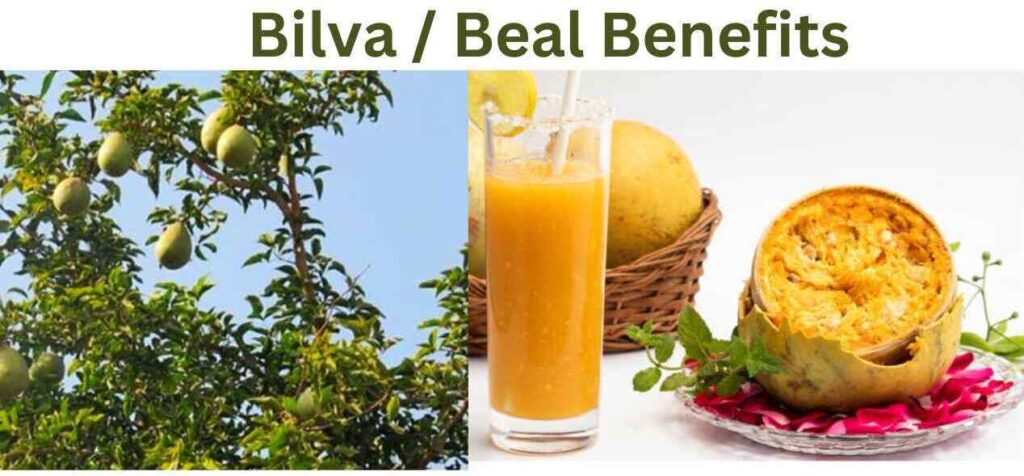- Bilva, scientifically known as Aegle marmelos, has many potential health benefits such as constipation, dysentery, diarrhoea, piles, regulate blood sugar levels, cough, asthma, and bronchitis, help in wound healing, and fever and infections.
- Bilva leaves of the Bilva tree, known as “Bilva Patra,” offering to Lord Shiva during prayers bring blessings and spiritual enlightenment.
- Bilva, with its manifold uses in medicine, spirituality, and cuisine, is a truly remarkable plant.
Synonyms
- Hindi- Beal, Belva, Shree Phal.
- English- Aegle marmelos, Wood apple, Elephant apple.
- Sanskrit: Bilva or Shivadruma.
- Tamil: Vilvam, Bilva pagam.
- Telugu: Maredu, maredu, bilva pandu.
- Gujarati Bili or Bilora, kothu fruit.
- Marathi: Bael or Kaveeth, Shandyal, Shailusha, Malur, and Shriphal, ‘Shiva Tripatrak’.
- Punjabi: Bel or Bael.
- Malayalam: Koovalam.
- Kannada: Belada Hannu.
- Indonesian: Maja.
- Chinese (Mandarin): Bílúo.
Benefits
- Bilva has anti-diarrheal properties that are useful for Diarrhoea, and Dysentery.
- Beal has natural laxative properties that help with indigestion and constipation.
- Useful in Bleeding Haemorrhoids/ piles.
- Fever.
- Helps in stabilizing blood sugar levels, making it beneficial for individuals with diabetes.
- Maintaining healthy cholesterol levels and supporting overall heart health.
- Help alleviate symptoms of asthma, bronchitis, and other respiratory conditions.
- Helps combat skin infections and supports a clear complexion, giving you a natural glow.
- Reducing stress and anxiety levels.
- Rich in vitamin C and other antioxidants, helps protect your body from harmful free radicals and boosts your ability to fight off infections.
- It has analgesic properties that can alleviate cramps and reduce the pain associated with menstruation.
How to Use Beal/ Bilva
1. Bilva Fruits Use in Dysentery- The Khada prepared the paste of tender Bilva fruits, and an equal quantity of sesamum paste, a supernatant layer of curd and added with sours and fat, this combination treats Pravahika (Dysentery).
2. Bilva Fruits used in Diarrhoea – In Kafaj Diarrhoea, if suffering from pain, tenesmus and Obstruction in the abdomen – should take tender bilva fruits, jaggery, sesamum oil, pippali (Piper longum) and Sunthi (Dry ginger) mix all in the same quantity and make a fine powder. Consume 1- teaspoon of Dhasmoola Khada.
3. Bilva Use in Non-Bleeding Piles –
If a piles patient has pain in the anus, make a decoction of wood apple leaves (Beal), mix some hot water, and take a sitz bath for 10-12 minutes. It also provides relief in the swelling of piles of warts.
4. Beal Use in Respiratory Problems
The decoction of the leaves is used as a febrifuge and expectorant in febrile Conditions and respiratory complaints, especially in asthmatic ailments.
5. Bilva Fruits used in IBS
Eating boiled pulp of raw Bilva fruit with honey Cures Irregular Bowel Syndrome.
6. Bilva Leaves in Diabetes Mellitus
The juice of leaves is orally given in diabetes mellitus as the plant drug is an antidiabetic agent.
7. Bilva pulp in Bleeding Piles –
Boiling the pulp of raw bilva fruit in a fire and mixing it with old jaggery or honey helps to stop bleeding from piles.
8. Bilva in Obesity (fat Reducer) –
Make Decoction (Kwath) of Bilva, Agnimantha (Clerodendrum phlomidis), Shyonak (Oroxylum indicum), Kashmari (Gmelina arborea), Patala (Stereospermum suaveolens), and mix Honey. This decoction helps to reduce fat.
9. Bilva oil used in Karanpuran – Karanpuran helps to treat ear problems such as hearing loss, whistling or other noises in the ears, ear pain, earwax and swelling.
Karanpuran should not be performed –If there is any injury, cut, wound or burning sensation in the ear, or the eardrum is ruptured then Karanpuran should not be performed.
**Karan Purna should always be performed under the supervision of a doctor.**
Doses
Powder 3–6-grams, Juice l2-24ml., Syrup 5 -10ml. (panaka), Decoction 40-80 grams (bark), Fruit pulp (ripe) 10–15 grams, Root bark powder 3–6 grams, Fruit pulp (unripe) 5-10gms.
**Disclaimer**– The Dosage of Bael depends on age, gender, health condition and formulation. It is important to consult an Ayurvedic doctor before using it.
Pharmacodynamics
- Rasa (Taste) – Khasaye, Tikta.
- Gunaa (Qualities) – Rukasa, Laghu.
- Virya (potent energy) – Usna.
- Vipaka (post-digestive effects)- Katu.
- Doshakarma(Special effects on Dosh) – Kaphvata shamak.
Chemical Composition
- Fruit contains – Marmalosin (Marmelosine).
- Young bark contains – coumarin and umbelliferon.
- Leaves contain – essential oil, consisting of a- and F phellandrene. Matured bark Y-fragrine, umbelliferon and marmesin, sterols and triterpenoids.
- Leaves contain 0.6% of essential oil mostly a compound of d-limonene. An aromatic yellowish-greenish oil obtained by pressing the seeds has laxative activity.
- Roots, leaves and bark contain mainly tannin.
Formulation (yoga) of Bilva in Ayurveda medicine
Bilvadi churan, Bilva taila, Bilvadi ghrita, Bilvamuladi Gutika, Gangadhara churan (laghu),
Dasamurlarista Kwatha.
Side Effects of Bilva
- Bilva in large quantities may lead to dizziness or fainting.
- Mouth dryness and constipation when consumed in excess.
- Pregnant and lactating women should exercise caution when consuming Bilva.
- Sensitive skin or a history of allergies may experience skin rashes or itching.
Refernce-
2. Bilva Fruits used in Diarrhoea – Charak Samhita. Chikitsa. 19-113
3. Bilva Use in Non-Bleeding Piles, Charak Samhita, Chikitsa 14-47
4. Beal Use in Respiratory Problems- Kaideva Nighantu -oshadhi Varga-19
5. Bilva Fruits used in IBS – Vangsena Samhita, Grahani Chiktsa,169.
6. Bilva in Obesity (fat Reducer) – Sarangdhara Samhita 2-2-117.
7. Bilva oil used in Karanpuran – cakradatta, karanroga 57-29.
8. DRAVYAGUNA_VIJANANA_vol_1 book. 411-430
9. Bhavprakash-Nighantu book.
**Disclaimer: The information provided here is only for knowledge and educational purposes.
It’s not a substitute for professional medical advice, diagnosis, or treatment.
Always consult with a qualified healthcare provider or physician for personalized guidance.**









Loving your blog and your content. Keep up the good work and please keep the content coming.